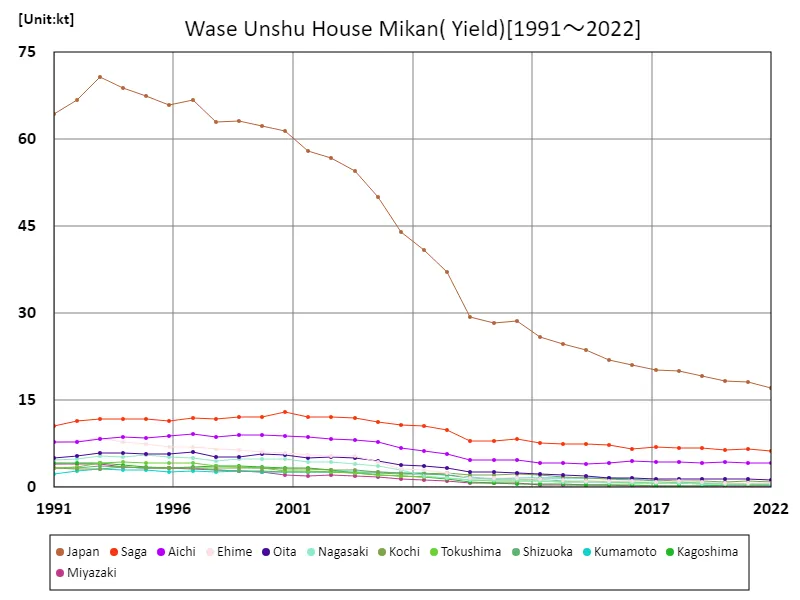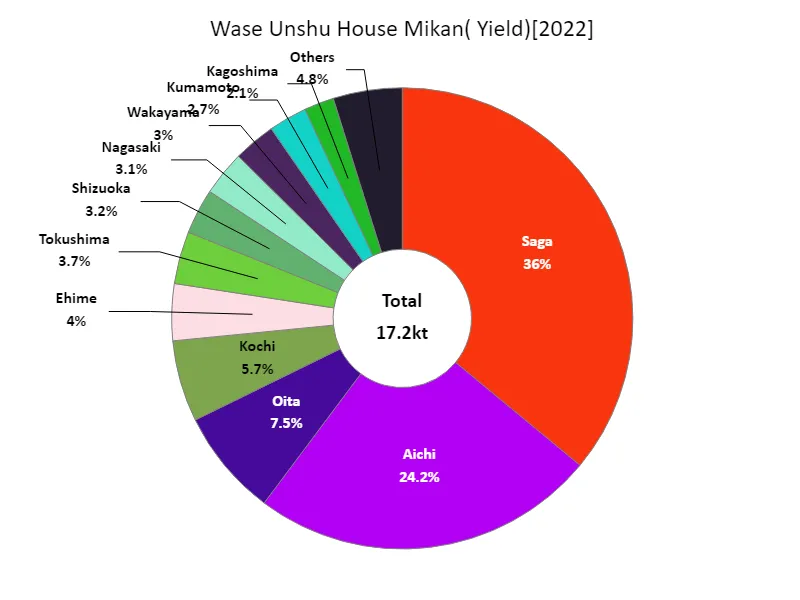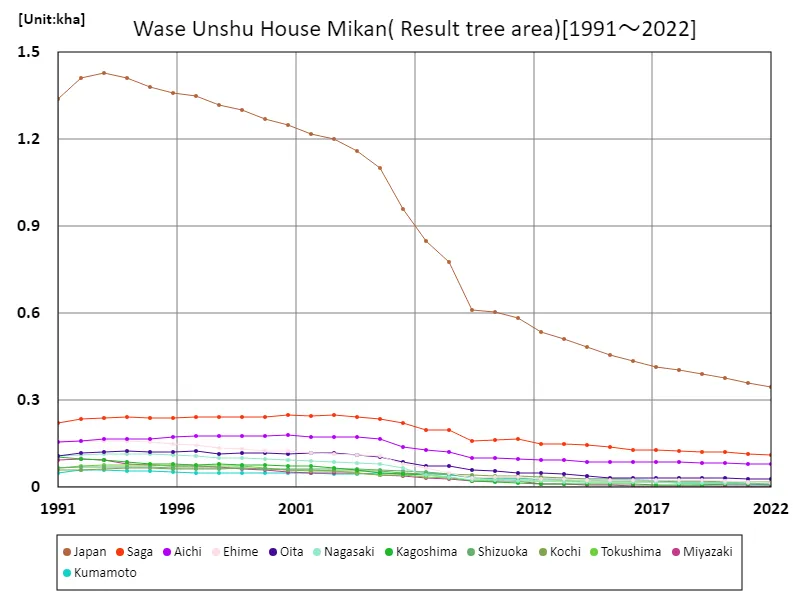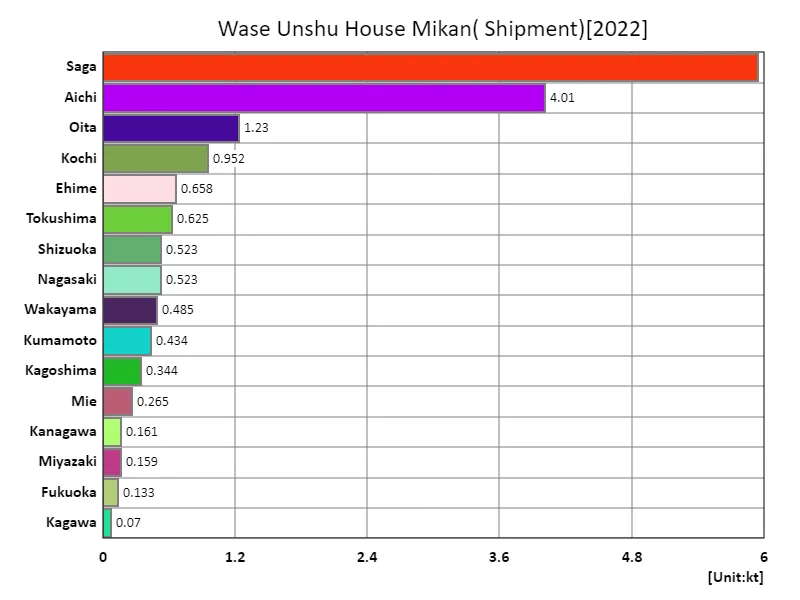- Abstract
- Harvest volume of early-ripening Unshu mandarins grown in greenhouses (main data).
- Harvest volume of early Unshu mandarin oranges grown in greenhouses (by prefecture).
- Area of bearing trees of early-ripening Unshu mandarin oranges grown in greenhouses (main data).
- The area of bearing trees of early Unshu mandarin oranges grown in greenhouses (by prefecture).
- Shipment volume of early Unshu mandarins grown in greenhouses.
- Reference
Abstract
This article provides an overview of mandarin orange cultivation in Japanese agriculture based on the latest data. The national harvest volume in 2022 will be 17.2 kilotons, the bearing tree area will be the highest in the country at 345 hectares, and Saga Prefecture will have the highest shipping volume at 5.95 kilotons. These figures show that mandarin orange cultivation is thriving throughout the country, with Saga Prefecture in particular leading the way in terms of shipping volume. Additionally, the area of fruiting trees is the largest in the country, indicating that mandarin orange cultivation is also large in scale. Based on past trends, it can be assumed that demand for mandarins is high and production is increasing accordingly. Advances in agricultural technology and favorable climatic conditions may have contributed to the expansion of mandarin orange cultivation.
Harvest volume of early-ripening Unshu mandarins grown in greenhouses (main data).
This article summarizes the harvest volume of early Unshu mandarin oranges grown in greenhouses in Japan, based on data from 1991 to 2022. The highest harvest volume nationwide was 70.8 kilotons in 1993, and since then the trend has been that it has now declined to 24.3% of the peak. This suggests that mandarin cultivation was thriving in the 1990s and that production expanded in response to demand. However, in recent years, production has been declining due to changes in greenhouse cultivation techniques and demand. In addition, production volumes vary from region to region, and the effects of climatic conditions and agricultural policies must also be taken into account. In general, mandarin orange harvest volumes fluctuate greatly, making it a challenge to balance supply and demand.


The maximum is 70.8kt[1993] of Japan, and the current value is about 24.3%
Harvest volume of early Unshu mandarin oranges grown in greenhouses (by prefecture).
In Japanese agriculture, we will provide an overview of mandarin orange harvest volumes based on the latest data by prefecture for 2022. The highest overall harvest for the year was 6.18 kilotons in Saga Prefecture, which is the current maximum. A recent trend is that Saga Prefecture is a major mandarin producing area, with the largest harvest in the country. Saga Prefecture has a warm climate and suitable soil conditions, making it ideal for growing mandarin oranges. Improvements in farmers’ techniques and cultivation management have also contributed to increased yields. On the other hand, mandarin oranges are also produced in other prefectures, and harvest volumes vary from region to region. Harvest volumes fluctuate from year to year due to changes in demand and weather conditions, but overall mandarin orange cultivation is stable, with Saga Prefecture in particular playing a central role.


The maximum is 6.18kt of Saga, the average is 1.07kt, and the total is 17.2kt
Area of bearing trees of early-ripening Unshu mandarin oranges grown in greenhouses (main data).
We will examine data from 1991 to 2022 on the area of fruiting trees in greenhouses for early-ripening Unshu mandarin oranges in Japan. The maximum area of bearing trees nationwide was recorded in 1993 at 1.43 thousand hectares, and the trend since then has been that it has now decreased to 24.1% of the peak. This suggests that the scale of mandarin orange cultivation expanded rapidly in the 1990s due to the spread of greenhouse cultivation techniques and increased demand. However, in recent years, due to changes in demand and agricultural policies, the area of fruiting trees has been showing a tendency to decrease. Additionally, the cultivated area varies from region to region, influenced by climatic conditions and land use. In general, the area of mandarin fruiting trees has fluctuated over time, and the balance between supply and demand and advances in agricultural technology will likely influence future trends in cultivated area.


The maximum is 1.43kha[1993] of Japan, and the current value is about 24.1%
The area of bearing trees of early Unshu mandarin oranges grown in greenhouses (by prefecture).
In the context of agriculture in Japan, we look at the latest 2022 prefecture-by-prefecture data on mandarin fruiting tree area. The maximum overall bearing tree area for that year was 111 hectares in Saga Prefecture, which is the current maximum. A notable feature so far has been that Saga Prefecture is a major mandarin orange producing area. Saga Prefecture has a warm climate and suitable soil conditions, making it ideal for growing mandarin oranges. Improvements in farmers’ techniques and cultivation management are also thought to have contributed to the increase in the area of fruit-bearing trees. Mandarin oranges are also grown in other prefectures, but the scale of cultivation tends to be smaller than in Saga Prefecture. Cultivation areas vary due to differences in climate and land use conditions from region to region. In general, the area of mandarin fruit trees fluctuates depending on the relationship between supply and demand and regional characteristics, with Saga Prefecture playing a central role. The area of mandarin fruiting trees is likely to fluctuate in the future due to changes in demand and advances in agricultural technology.


The maximum is 111ha of Saga, the average is 21.6ha, and the total is 345ha
Shipment volume of early Unshu mandarins grown in greenhouses.
We will examine the shipping volume of early-ripening Unshu mandarins, including those grown in greenhouses, in Japanese agriculture, based on the latest data from 2022. The highest overall shipment was from Saga Prefecture at 5.95 kilotons, with an average of 1.03 kilotons, for a total of 16.5 kilotons. A notable feature so far has been that Saga Prefecture has been a major shipping area for mandarin oranges. Saga Prefecture has a warm climate and suitable soil conditions, making it ideal for growing mandarin oranges. This makes it clear that the shipment volume is the largest in the country. Additionally, the average shipping volume was 1.03 kilotons, indicating that mandarin orange shipments were relatively stable. However, shipment volumes vary by region and may be affected by fluctuations in demand and production. Overall, mandarin orange shipping volumes are stable, mainly in Saga Prefecture, and a production system has been established to meet demand. There is a possibility that shipment volumes will fluctuate in the future due to changes in demand and advances in agricultural technology, but at present the trend is stable.


The maximum is 5.95kt of Saga, the average is 1.03kt, and the total is 16.5kt



Comments